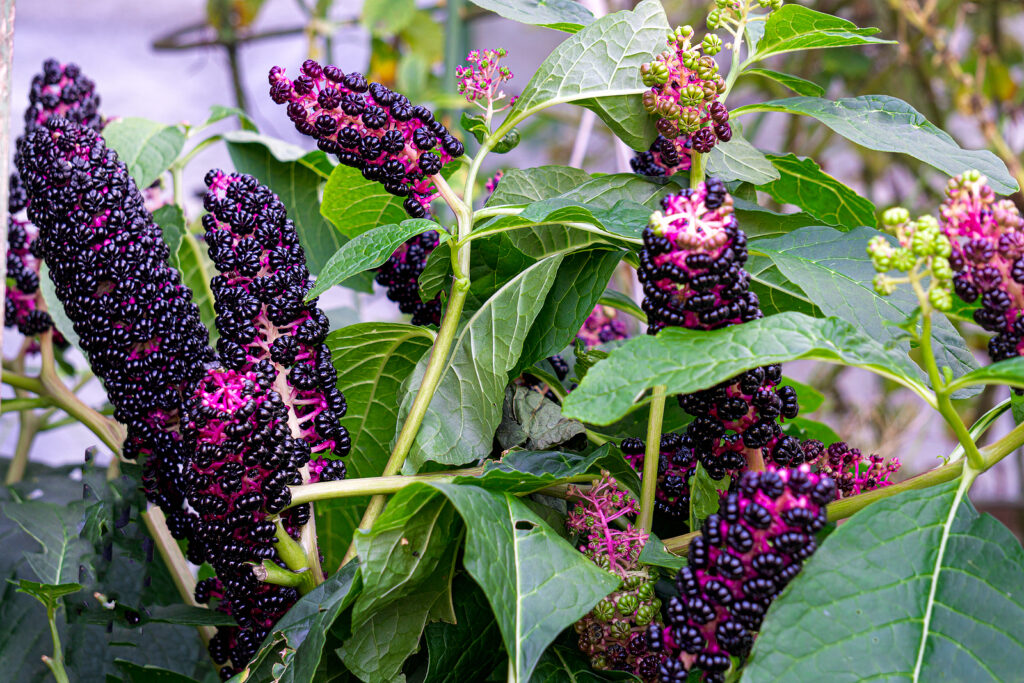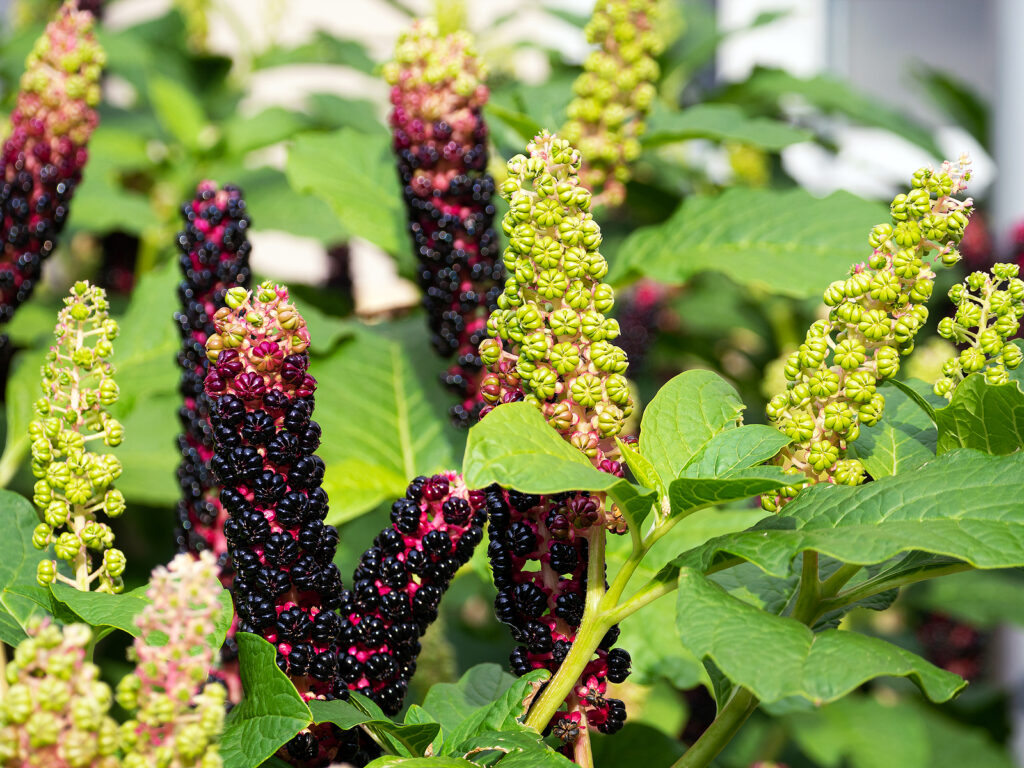Phytolacca – commonly called Pokeweed– are grown for their attractive autumn foliage and their decorative fruit. Leaves are ovate to elliptic and the perennial species have colored stems. Panicles of small, shallowly cup-shaped flowers are followed by spherical dark red to blackish-purple berries.
Grow Phytolacca in a larger border, light woodland, or waterside planting. Phytolacca grows best in moist soil in full sun or partial shade.
Phytolacca is a genus of about 25 species of perennials, shrubs, and trees. Phytolacca are native to open fields and woodlands in tropical and subtropical areas of North and South America and Africa and Asia.

Get to know Phytolacca
- Plant type: Perennials, shrubs, and trees
- Growing zones and range: Zones 5 to 9
- Hardiness: Hardy to Zone 5
- Height and width: Varies by variety, generally to 6 feet (2m) tall and 4 feet (1.2m)
- Growth rate: Moderate
- Foliage: Leaves are alternate, ovate to elliptic, and entire, and most have colorful stems
- Flowers: Racemes or panicles of small, shallowly cup-shaped, white to pink, petalless flowers
- Fruits: Spherical, dark, glossy, red to blackish purple berries
- Bloom time: Midsummer to early autumn
- Uses: Large border, light woodland, water-side planting, large gardens
- Garden companions:
- Common name: Pokeweed
- Botanical name: Phytolacca
- Family name: Phytolaccaceae
- Origin: Africa, Asia, and North to America
Where to plant Phytolacca
- Plant Phytolacca in full sun or partial shade.
- Plant Phytolacca in fertile, moist soil.
When to plant Phytolacca
- Sow Phytolacca seed 55-64°F (13-18°C) in early spring or autumn.
- Set container-grown Phytolacca in the garden in spring or autumn.

Planting and spacing Phytolacca
- Space Phytolacca 2 or 3 feet (.6-.9m) apart.
- Support taller Phytolacca in open areas.
How to water and feed Phytolacca
- Keep Phytolacca continuously moist.
- Feed Phytolacca with an all-purpose organic fertilizer in spring.
How to care for Phytolacca
- Take care to aggressively root out any seedlings that pop up.
Phytolacca pests and diseases
- Phytolacca may develop leaf spots and virus mosaic diseases.
Phytolacca propagation
- Divide perennial Phytolacca in summer.
- Phytolacca self-sows freely, possibly becoming invasive in certain conditions.
Phytolacca varieties to grow
- Phytolacca americana, Pigeon berry, Pokeweed, Red ink plant, erect perennial with branching, red-marked stems and fleshy roots. Ovate to lance-shaped, mid-green leaves, 6-12 inches (15-30cm) long, are purple-tinged in autumn. From midsummer to early autumn, bears white to pink flowers, .4 (9mm) across, in racemes 8 inches (20cm) long; these elongate to 12 inches (30cm), and are usually pendent when bearing the blackish maroon berries (highly toxic if ingested). To 12 feet (4m) tall and 3 feet (1m) wide. East North America to Mexico.
- P. clavigera, less aggressive and tidier than other species. It has oval green leaves with white midribs and long trusses of pink flowers. Hardy in Zone 6.
- P. polyandra, erect, shrubby perennial with stems becoming vivid crimson. Ovate to elliptic, mid-green leaves, to 12 inches (30cm) long, turn yellow in autumn. In late summer, purplish pink flowers, .4 inch (9mm) across, are produced in erect, compact racemes, to 7 inches (18cm) long, elongating to 12 inches (30cm) long when bearing the dense masses of black berries. To 6 feet (2m) tall and 24 inches (60cm) wide. China.















